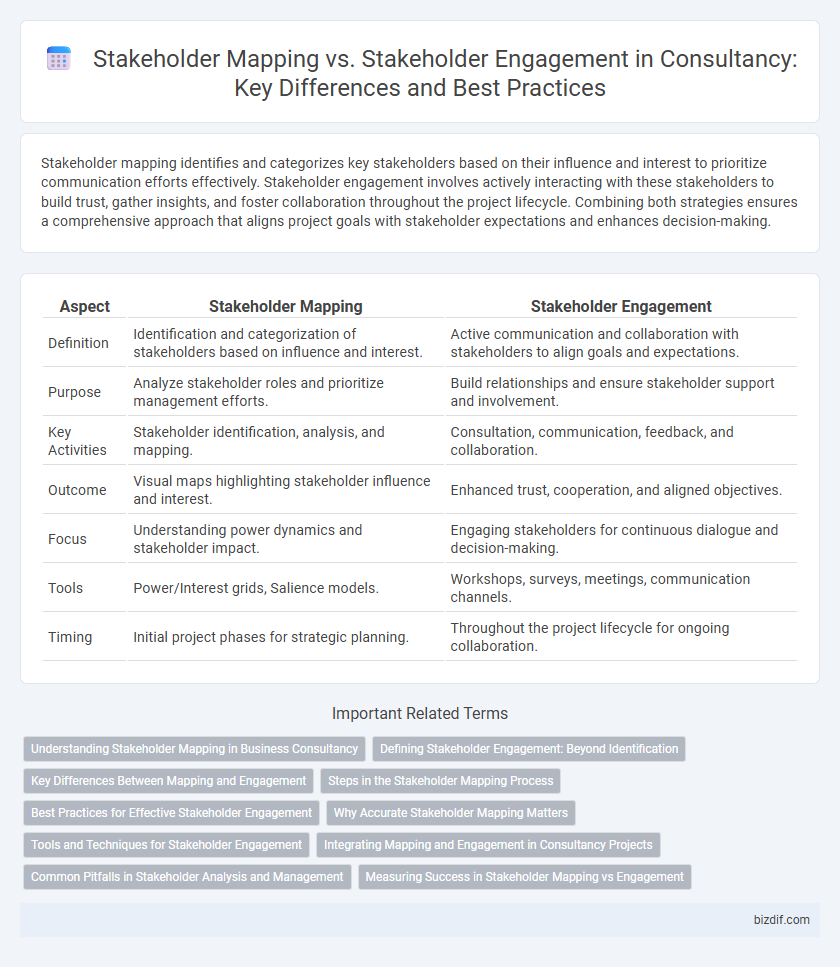Stakeholder mapping identifies and categorizes key stakeholders based on their influence and interest to prioritize communication efforts effectively. Stakeholder engagement involves actively interacting with these stakeholders to build trust, gather insights, and foster collaboration throughout the project lifecycle. Combining both strategies ensures a comprehensive approach that aligns project goals with stakeholder expectations and enhances decision-making.
Table of Comparison
| Aspect | Stakeholder Mapping | Stakeholder Engagement |
|---|---|---|
| Definition | Identification and categorization of stakeholders based on influence and interest. | Active communication and collaboration with stakeholders to align goals and expectations. |
| Purpose | Analyze stakeholder roles and prioritize management efforts. | Build relationships and ensure stakeholder support and involvement. |
| Key Activities | Stakeholder identification, analysis, and mapping. | Consultation, communication, feedback, and collaboration. |
| Outcome | Visual maps highlighting stakeholder influence and interest. | Enhanced trust, cooperation, and aligned objectives. |
| Focus | Understanding power dynamics and stakeholder impact. | Engaging stakeholders for continuous dialogue and decision-making. |
| Tools | Power/Interest grids, Salience models. | Workshops, surveys, meetings, communication channels. |
| Timing | Initial project phases for strategic planning. | Throughout the project lifecycle for ongoing collaboration. |
Understanding Stakeholder Mapping in Business Consultancy
Stakeholder mapping in business consultancy involves identifying and categorizing stakeholders based on their influence, interest, and impact on project outcomes, enabling tailored strategies for engagement. This process provides a strategic foundation by visually representing relationships and power dynamics, which guides resource allocation and communication plans. Effective stakeholder mapping enhances decision-making by aligning business objectives with stakeholder expectations and potential risks.
Defining Stakeholder Engagement: Beyond Identification
Stakeholder engagement extends beyond stakeholder mapping by actively involving stakeholders in decision-making processes rather than merely identifying and categorizing them. Effective engagement fosters collaboration, trust, and ongoing communication, which leads to better alignment with organizational goals and improved project outcomes. Prioritizing continuous interaction with stakeholders allows consultancy firms to address concerns proactively and enhance stakeholder satisfaction throughout the project lifecycle.
Key Differences Between Mapping and Engagement
Stakeholder mapping identifies and categorizes individuals or groups based on their influence, interest, and impact on a project, enabling strategic prioritization. In contrast, stakeholder engagement involves proactive communication and collaboration to build relationships, address concerns, and ensure ongoing participation. Key differences lie in mapping's analytical focus on identification and positioning, while engagement emphasizes dynamic interaction and feedback management.
Steps in the Stakeholder Mapping Process
Stakeholder mapping involves identifying, categorizing, and prioritizing individuals or groups based on their influence and interest in a project, using steps such as stakeholder identification, analysis, and visualization through matrices or grids. This process enables consultants to strategically plan interactions by segmenting stakeholders into groups such as key players, supporters, blockers, or marginal players. Effective stakeholder engagement follows mapping and focuses on tailored communication and involvement strategies to align stakeholder expectations with project objectives.
Best Practices for Effective Stakeholder Engagement
Effective stakeholder engagement requires identifying and analyzing key stakeholders through comprehensive stakeholder mapping to prioritize communication and involvement efforts. Best practices include continuous feedback loops, transparent communication, and tailored engagement strategies aligned with stakeholder interests and influence levels. Leveraging digital tools for real-time tracking and fostering trust through consistent dialogue enhances collaboration and project success.
Why Accurate Stakeholder Mapping Matters
Accurate stakeholder mapping identifies key individuals and groups influencing a project's success, enabling targeted communication and resource allocation. Precise mapping minimizes risks by highlighting stakeholder interests, power, and potential impact early in the consultancy process. Effective stakeholder engagement relies on this foundation, ensuring collaboration aligns with strategic objectives and drives project outcomes.
Tools and Techniques for Stakeholder Engagement
Stakeholder mapping involves categorizing stakeholders based on their influence, interest, and impact, using tools like power-interest grids and stakeholder matrices to visualize relationships. Stakeholder engagement employs techniques such as surveys, interviews, workshops, and communication plans to actively involve stakeholders and build trust throughout the project lifecycle. Effective use of digital platforms and collaboration software enhances real-time feedback and communication, optimizing engagement strategies for better project outcomes.
Integrating Mapping and Engagement in Consultancy Projects
Combining stakeholder mapping and stakeholder engagement enhances consultancy project effectiveness by identifying key stakeholders and tailoring communication strategies to their interests and influence. Mapping provides a structured analysis of stakeholder power, interest, and impact, while engagement fosters ongoing dialogue and collaboration to address concerns and build trust. Integrating these processes ensures dynamic stakeholder management, aligning project objectives with stakeholder expectations and improving decision-making outcomes.
Common Pitfalls in Stakeholder Analysis and Management
Stakeholder mapping often falls short by oversimplifying relationships, leading to missed nuances in influence and interest, which hampers effective stakeholder engagement. Common pitfalls include failing to update maps regularly, ignoring less vocal stakeholders, and overlooking the dynamic nature of stakeholder priorities. Effective management requires continuous analysis and adaptive engagement strategies to mitigate these risks and foster collaborative outcomes.
Measuring Success in Stakeholder Mapping vs Engagement
Measuring success in stakeholder mapping involves assessing the accuracy and depth of identified stakeholders, their influence, and interest levels to ensure comprehensive coverage. In stakeholder engagement, success metrics focus on the quality of communication, stakeholder involvement, and the impact of engagement activities on project outcomes. Effective consultancy leverages both approaches by continuously evaluating mapping accuracy and engagement effectiveness to drive informed decision-making and stakeholder satisfaction.
Stakeholder Mapping vs Stakeholder Engagement Infographic

 bizdif.com
bizdif.com